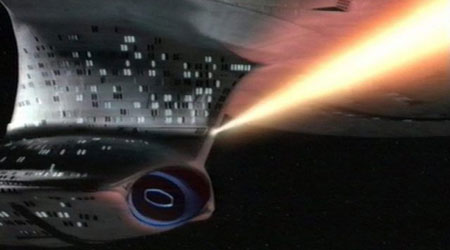Phasers, or PHASed Energy Rectification, are the primary sub-light weapon used by most advanced space-faring races, most notably the United Federation of Planets, for ship-to-ship and ship-to-ground combat.
The first phasers were designed to replaced primitive EM weapons such has lasers and particle beam accelerators. Phasers and EM weapons both share a common design lineage in practical directed energy devices created for early starship to clear dust and small meteorites from their flight path. Phasers in their current form came into wide spread service during the 2200's, with most Starfleet ships being equipped with them by the 2250's. Today phasers are used on board starships to place a high energy beam on a hostile target's hull in order to damage or destroy the vessel. Phasers can also be configured for multiple non-destructive purposes such as low energy scans or drilling operations.
The energy released by phasers is created by the rapid nadion effect (RNE); nadions are subatomic particles that interact with certain types of superconducting crystals called fushigi-no-umi. When the nadions interact with the crystal, the strong atomic force is freed from the nuclei of the crystals' atoms; the strong force is then transferred to the phaser's output beam.
The basic component of the ship's phasers is the emitter. The phaser emitter is composed of an EPS power system, a prefire chamber, and several emitter crystals to allow discharge in multiple directions. A couple hundred phaser emitters may be arranged linearly to form large phaser arrays.
The phaser emitters are powered by the ships EPS system, when the firing sequence starts, plasma from the EPS conduits is discharged into the plasma distribution manifold. Plasma flows from the manifold to each of the phaser emitters where it enters the prefire chamber. In the prefire chamber the plasma energy undergoes an EM spectrum shift and is released to the emitter crystals to create the RNE effect. Once the energy is discharged from the emitter crystal it flows into the neighboring emitter due to force coupling effects. Energy from each emitter segment converges to a final discharge point where the phaser beam is released. The starship's firing computer can control the direction and power level of the beam emitted by controlling the flow of EPS plasma of each emitter and the direction it is released to the emitter crystal.
Starfleet uses a common phaser array layout for most of its starships. There are two primary large dorsal and ventral arrays wrapped around the saucer section. There may also be numerous smaller phaser arrays on the stardrive section and nacelles. This configuration gives a starship a near 360 degree firing arc in all directions. Most Starfleet ships are equipped with type X phasers which have a maximum power output of 5.1 MW per emitter segment and an effective range of 300,000 kilometers. Phaser recharge time is less the 0.5 seconds with a sustained full power fire time of 45 minutes. New Starfleet ships are now equipped with type XII phasers; performance specifications of these weapons are classified. Older vessels still in service may be equipped with type VII-IX phasers with significantly downgraded specs.
Phasers can be countered by the use of EM shielding on the threat vessels. Depending on technology level a single phaser hit may not be able to penetrate a vessel's shields, but continuous phaser hits should start to weaken the shielding, overwhelming the shield generator power systems. Shields may also be overcome by matching the phaser and shield frequency. A vessel's own shields will not affect phaser fire due to the polarization of the shields.
Recent phaser advance now allow phasers to be used at warp speed by use of a annular confinement beam around the phaser. This prevents dissipation of the phaser energy in the presence of warp fields. Other recent phaser improvements include pulse fire cannons and phaser frequency rotation.



